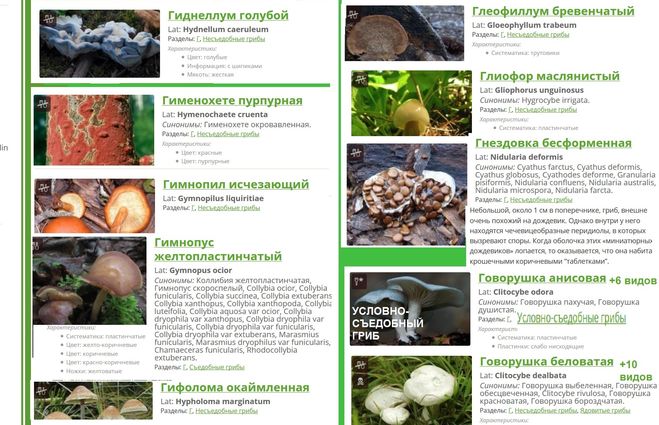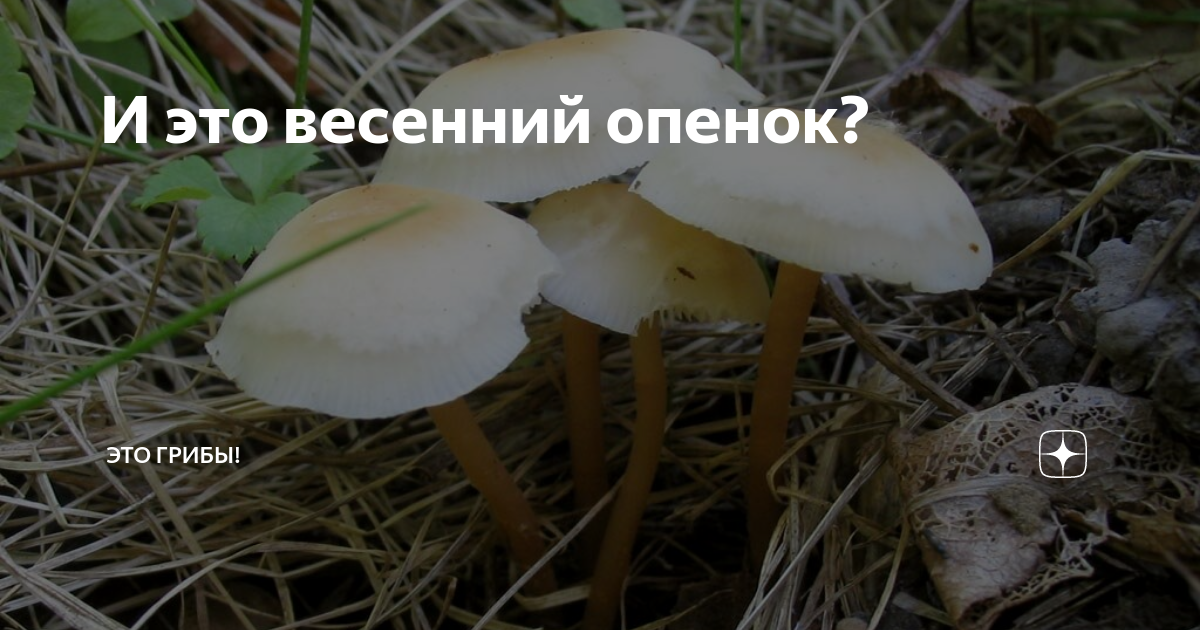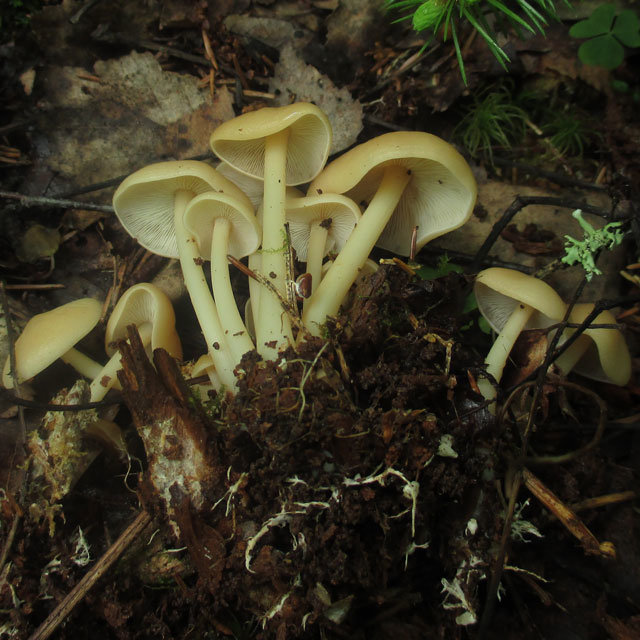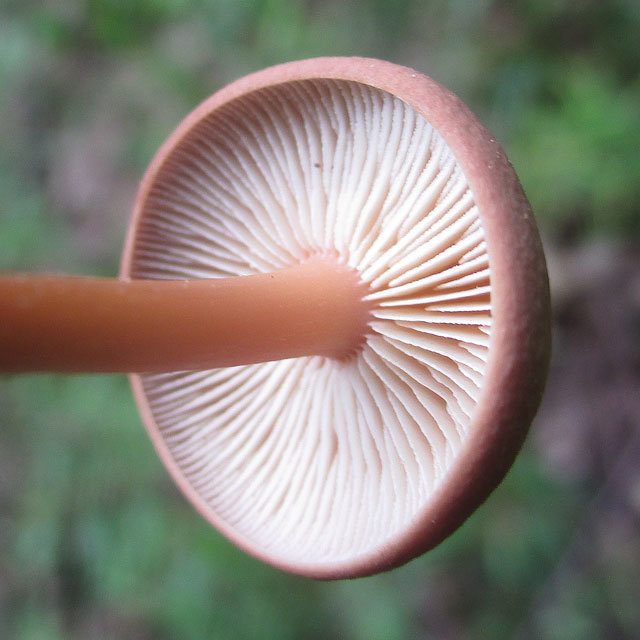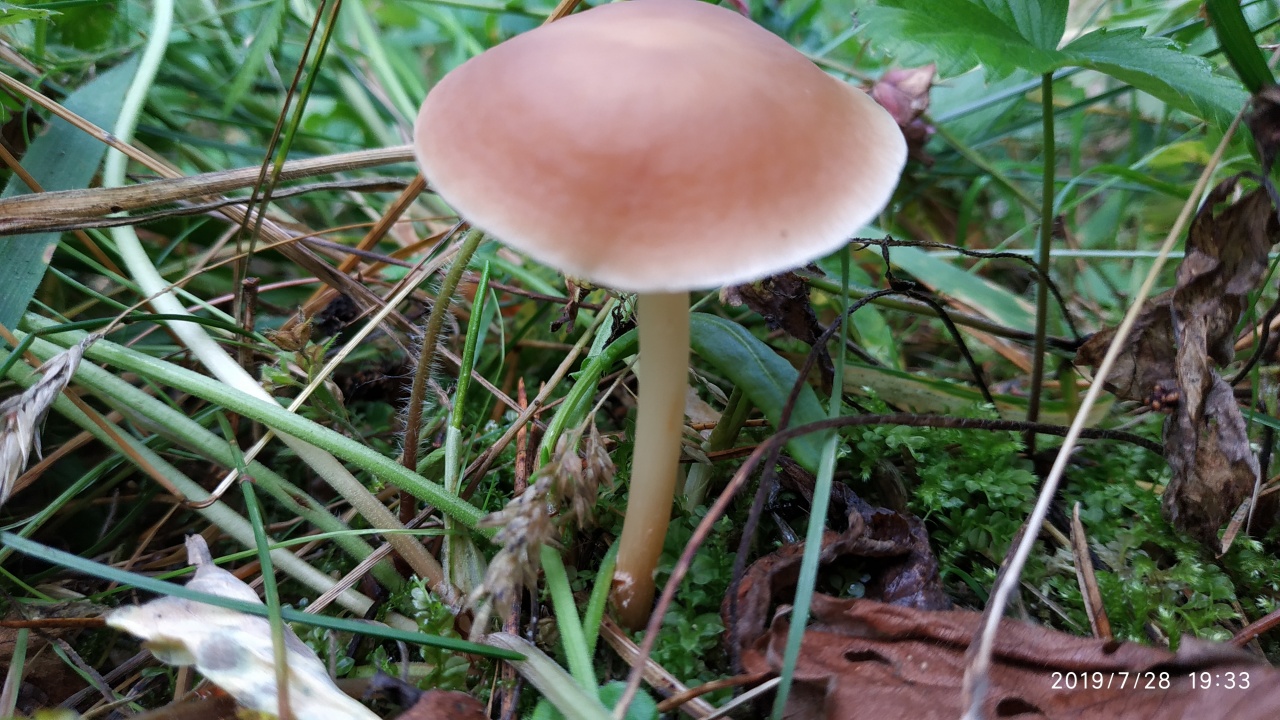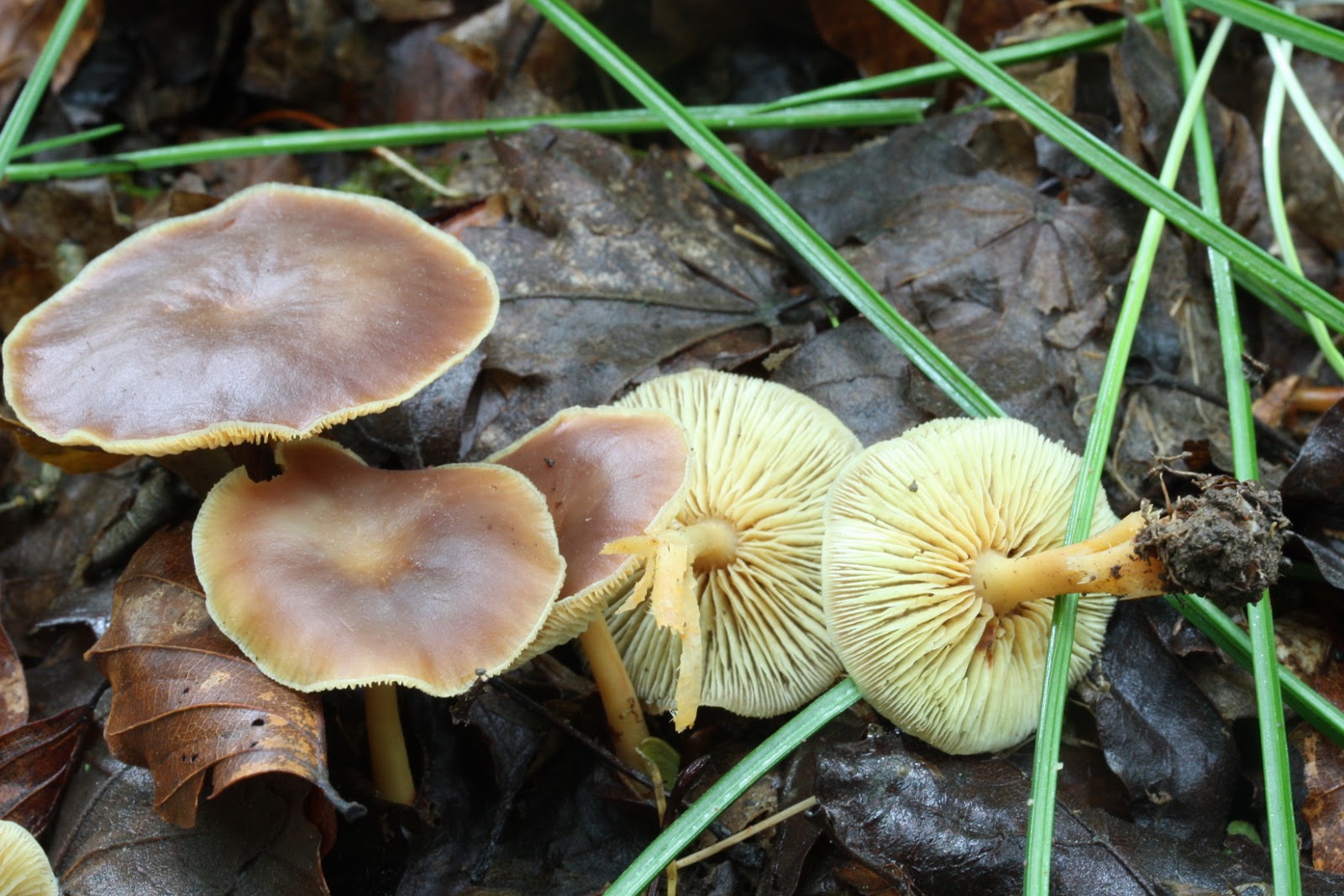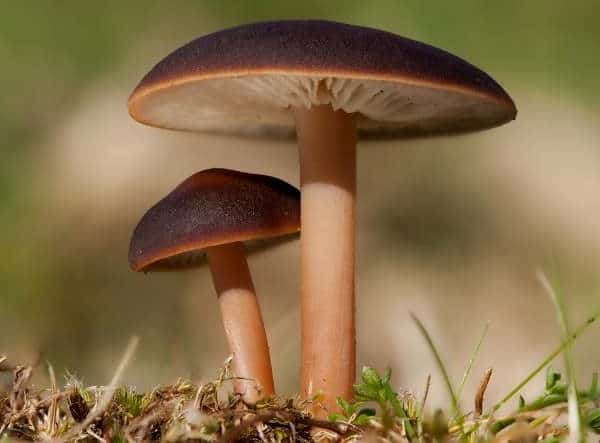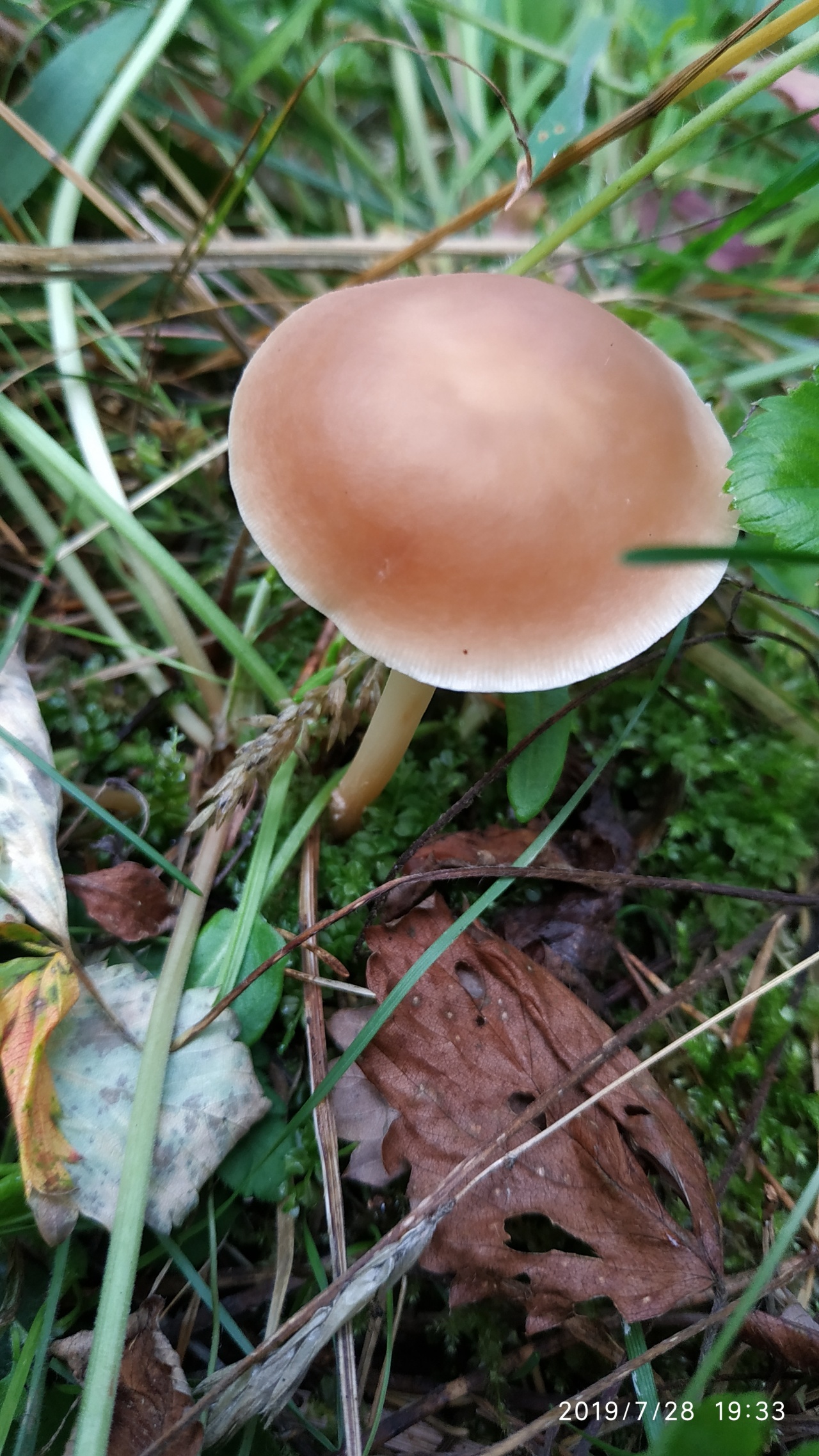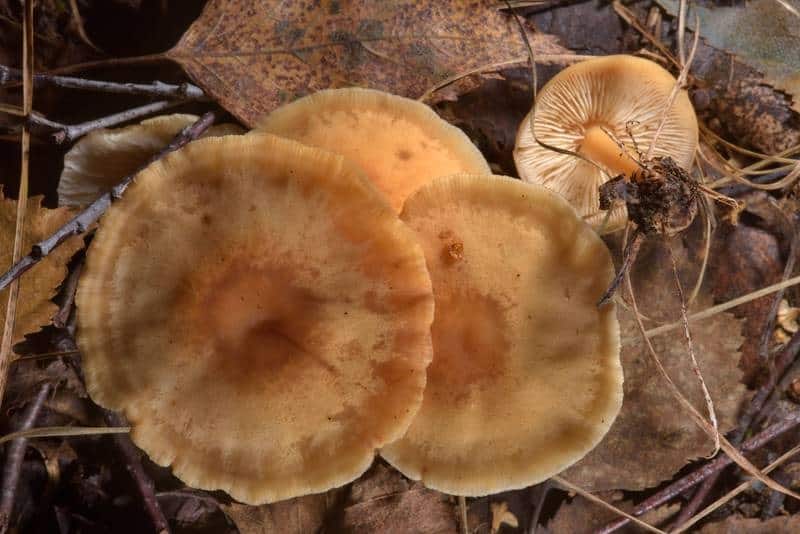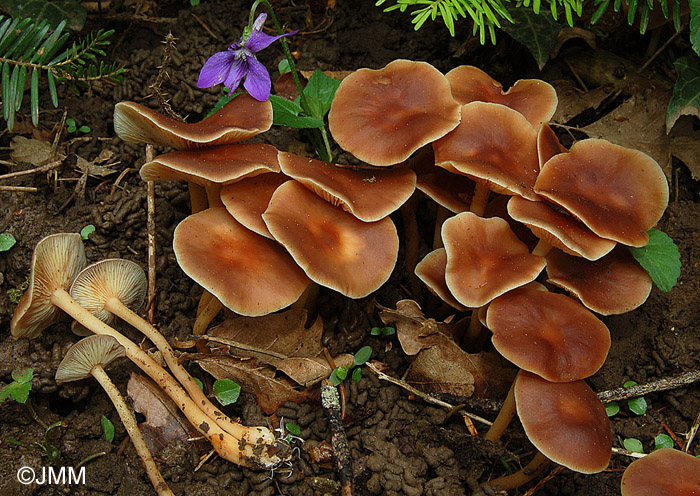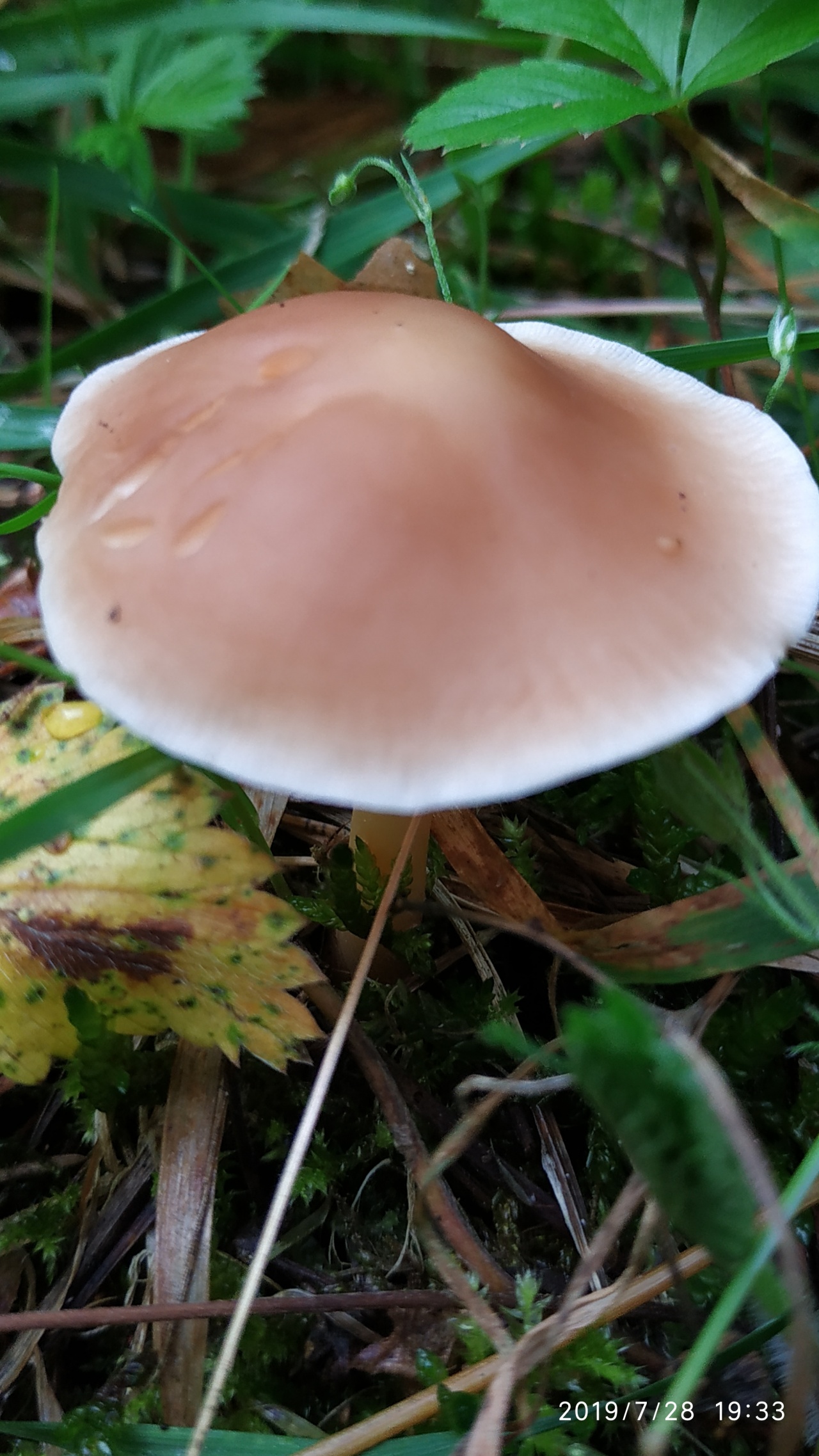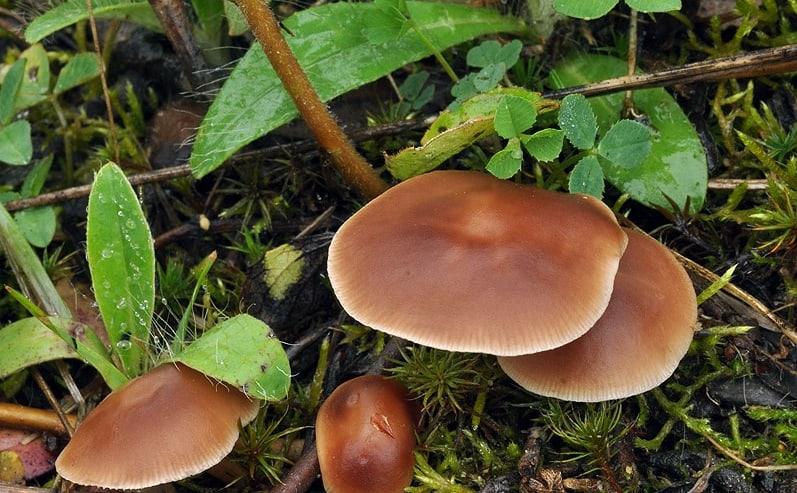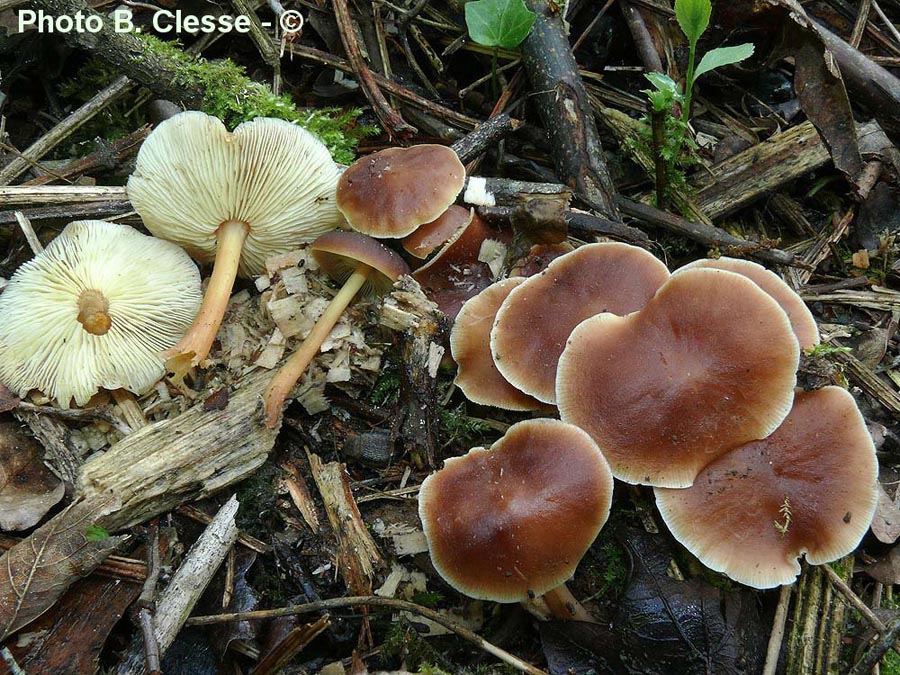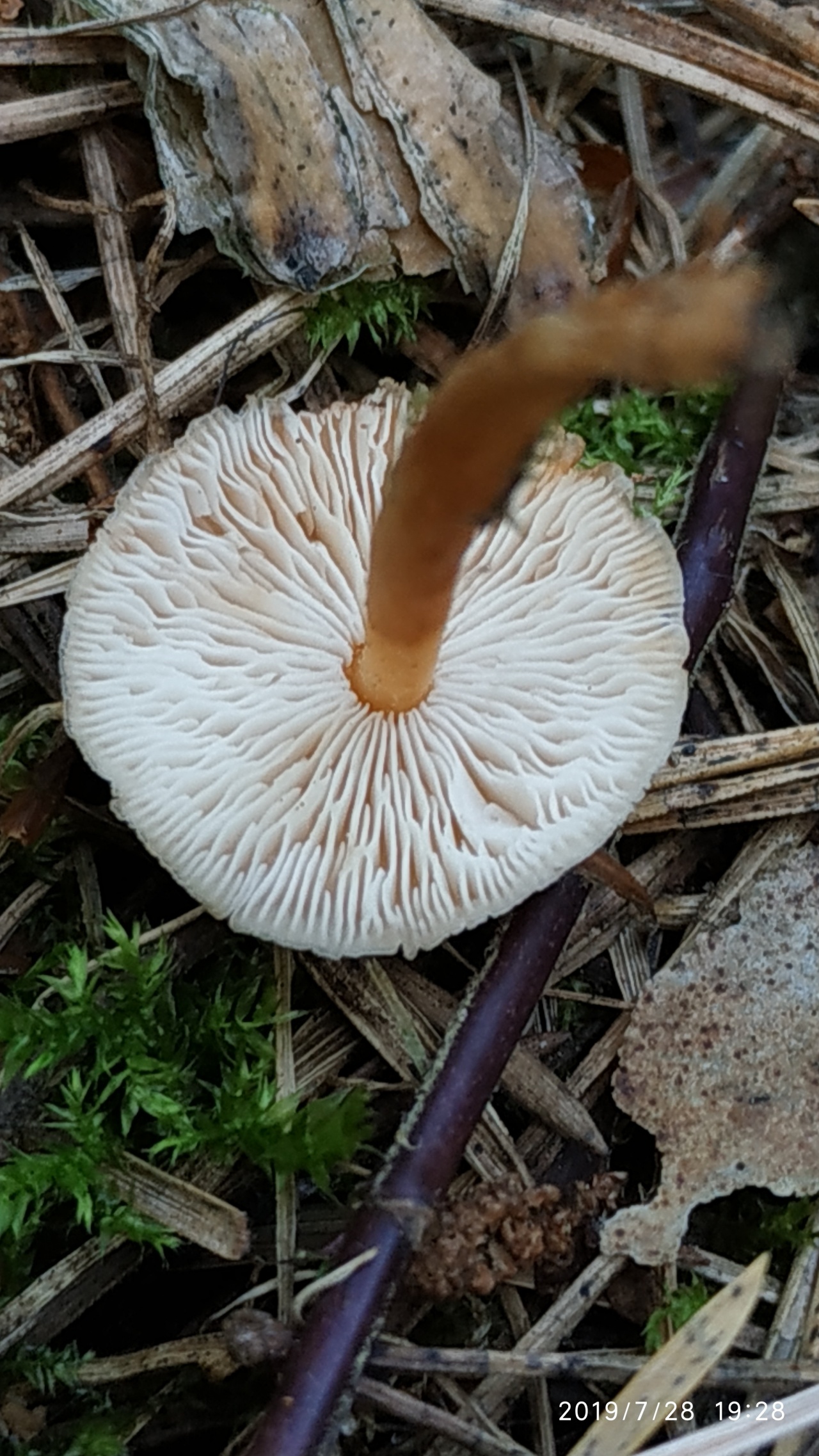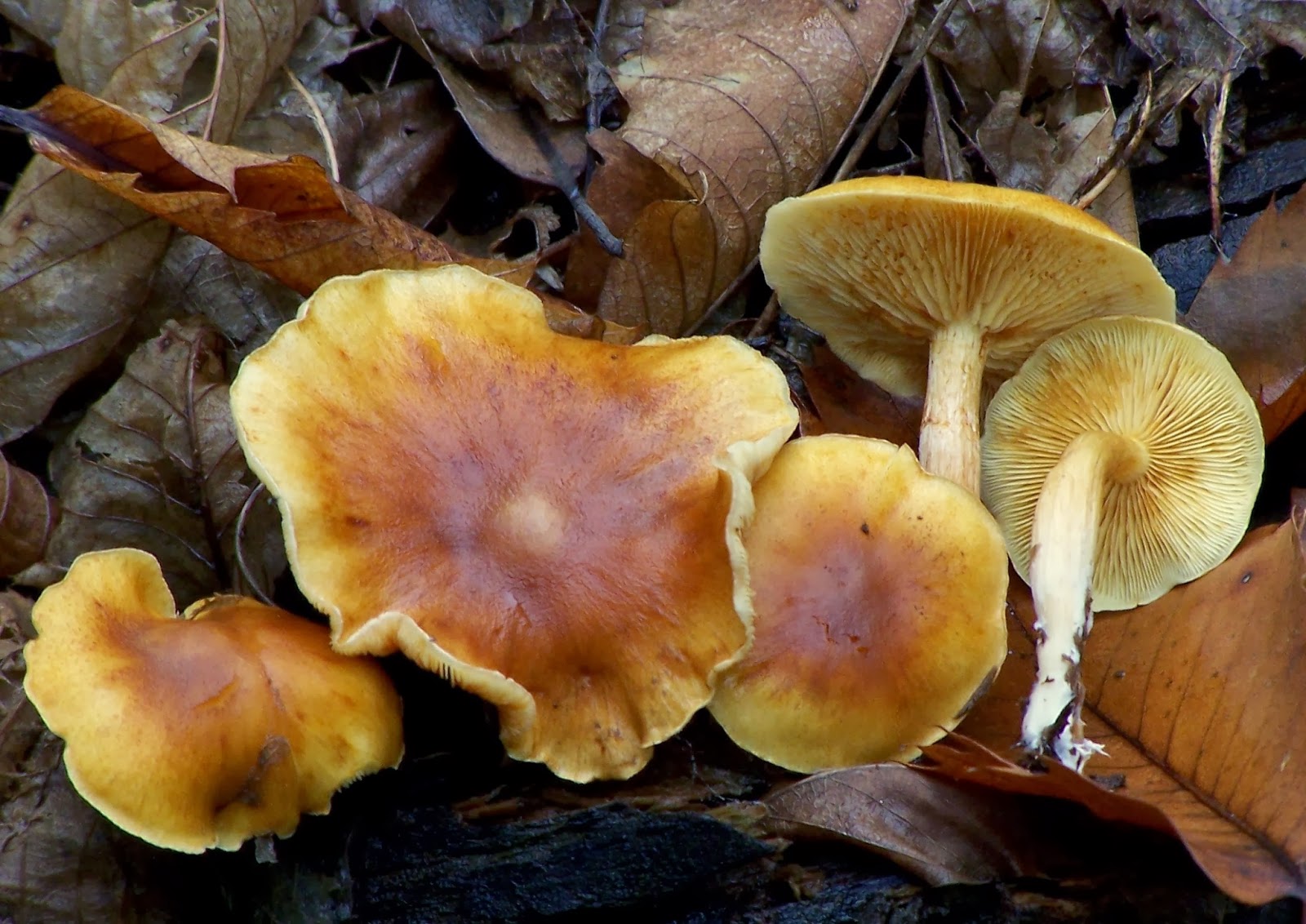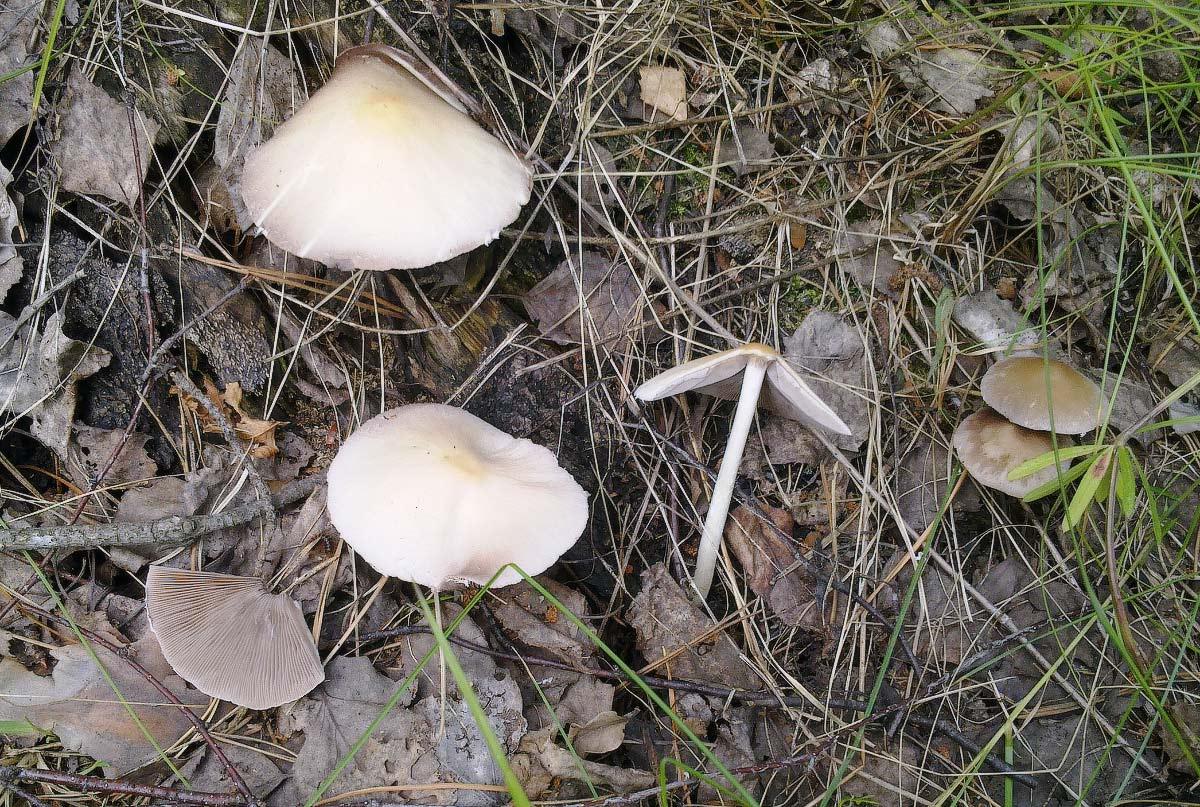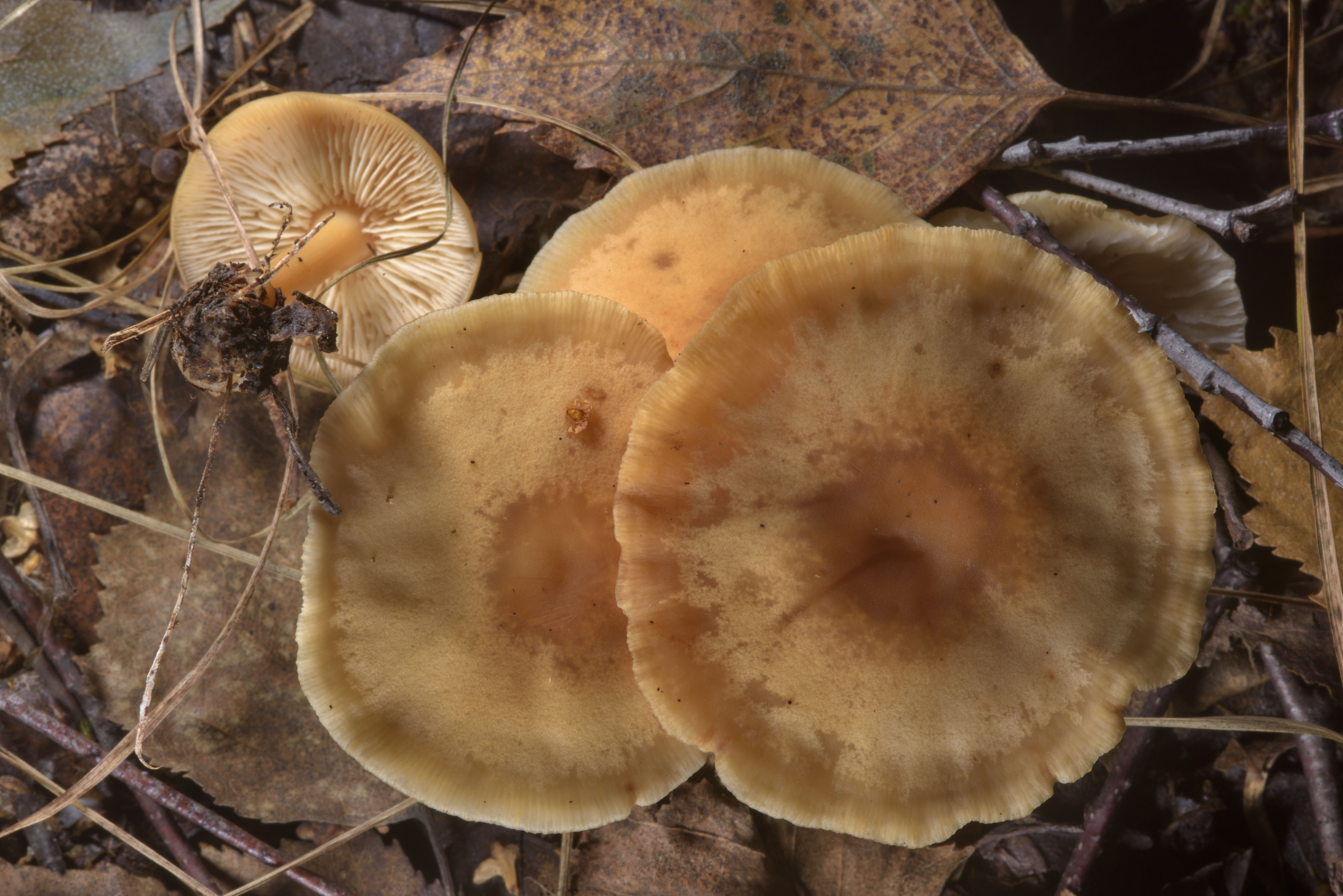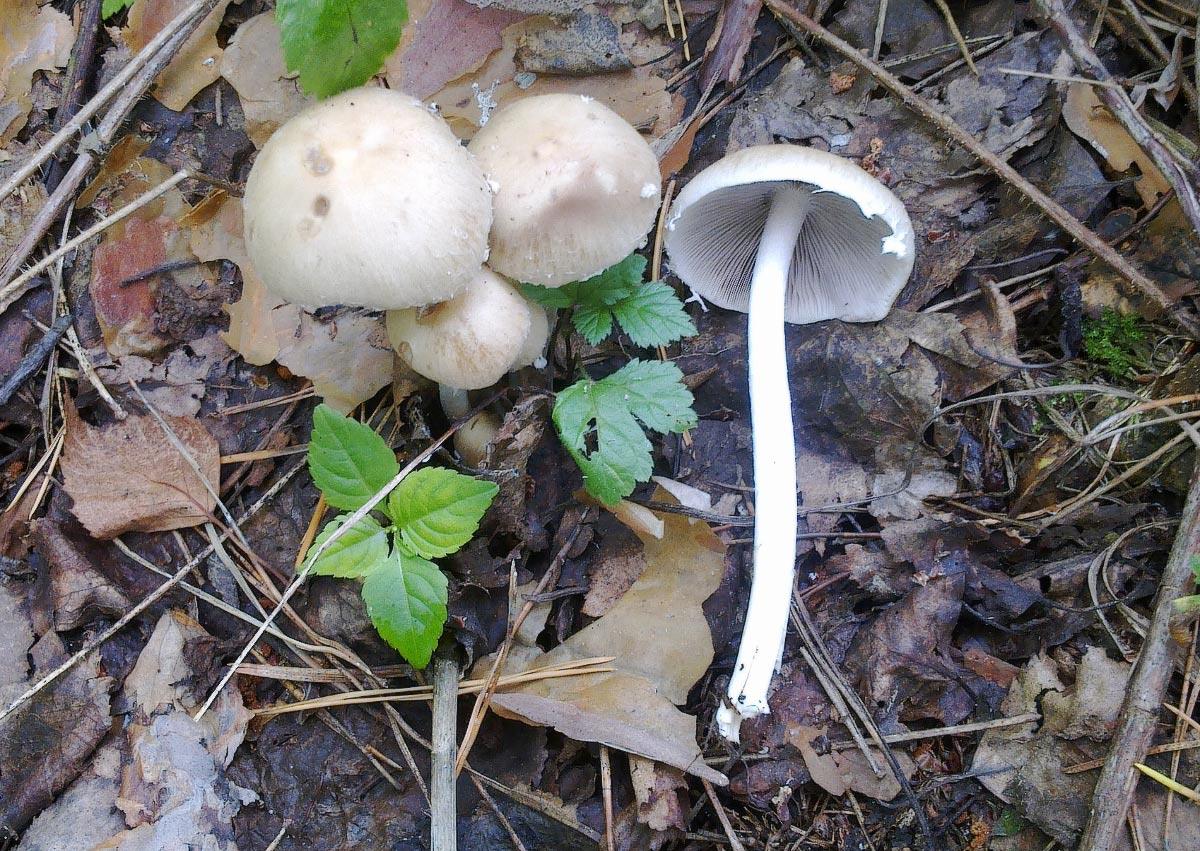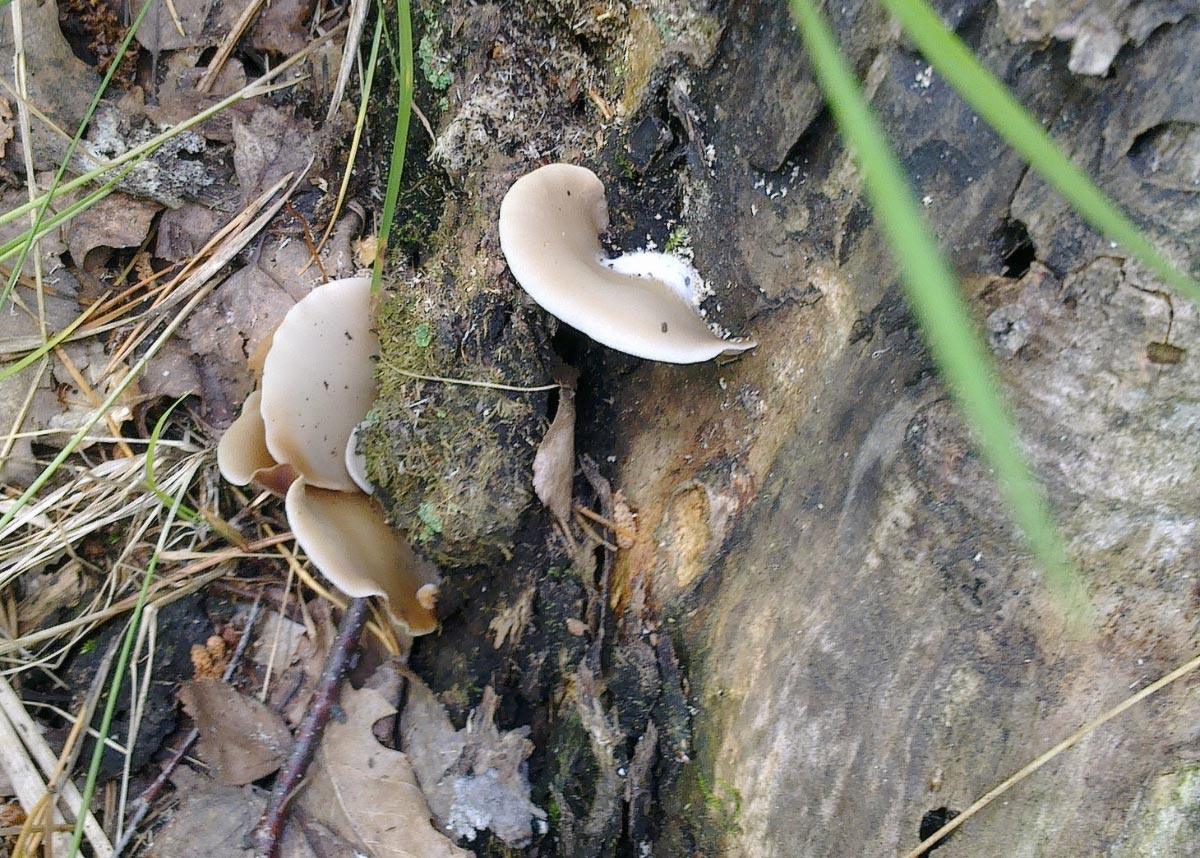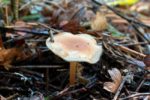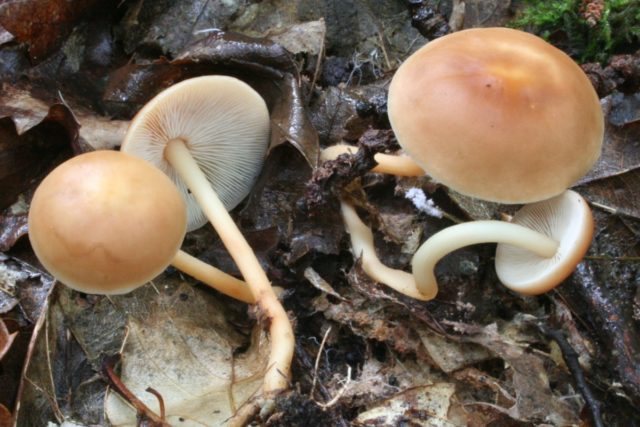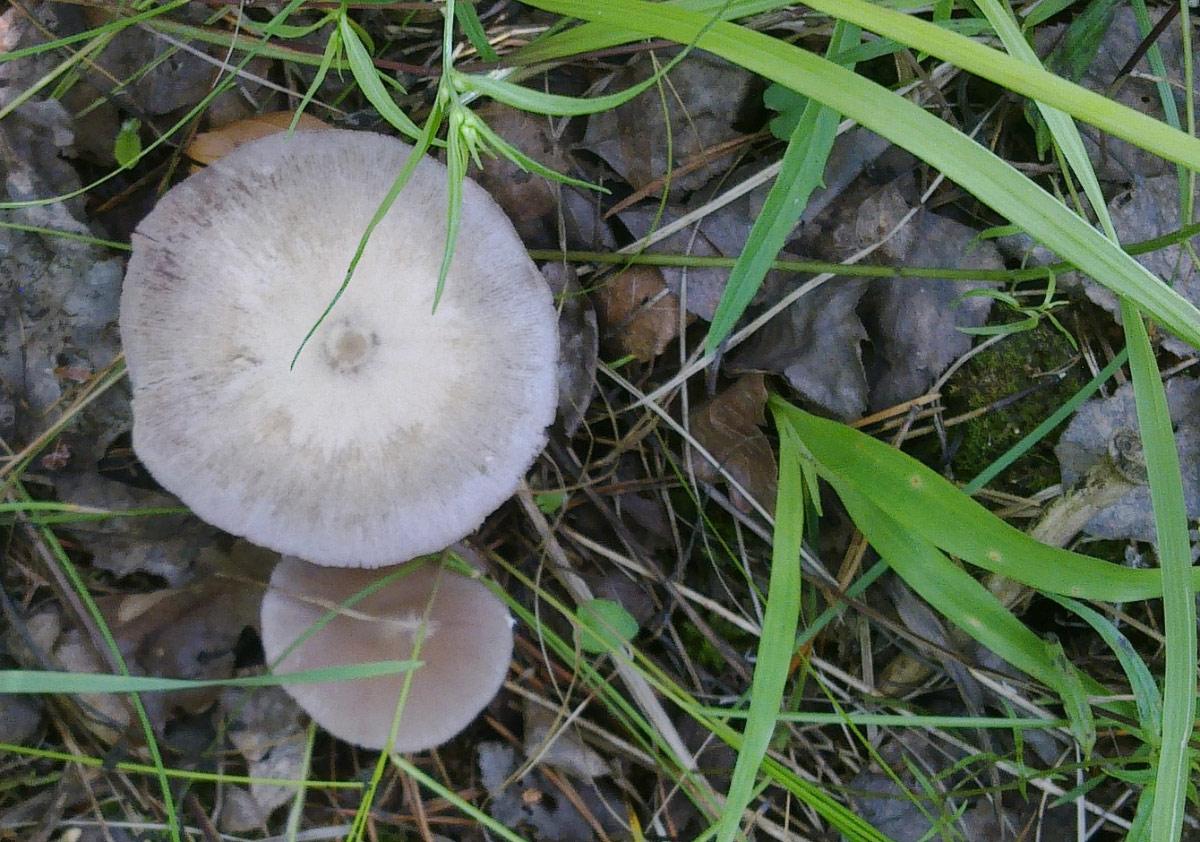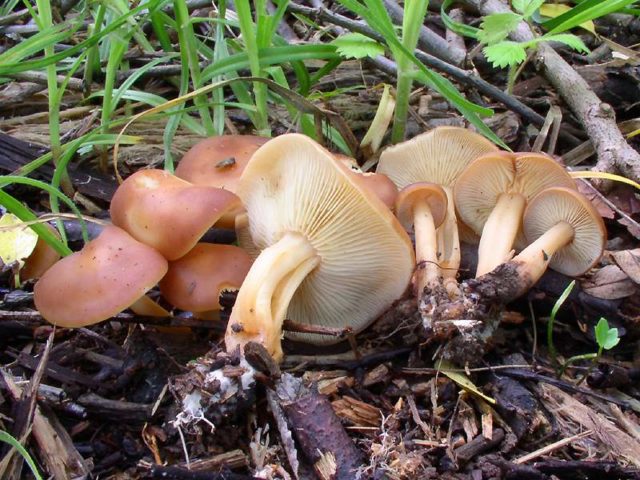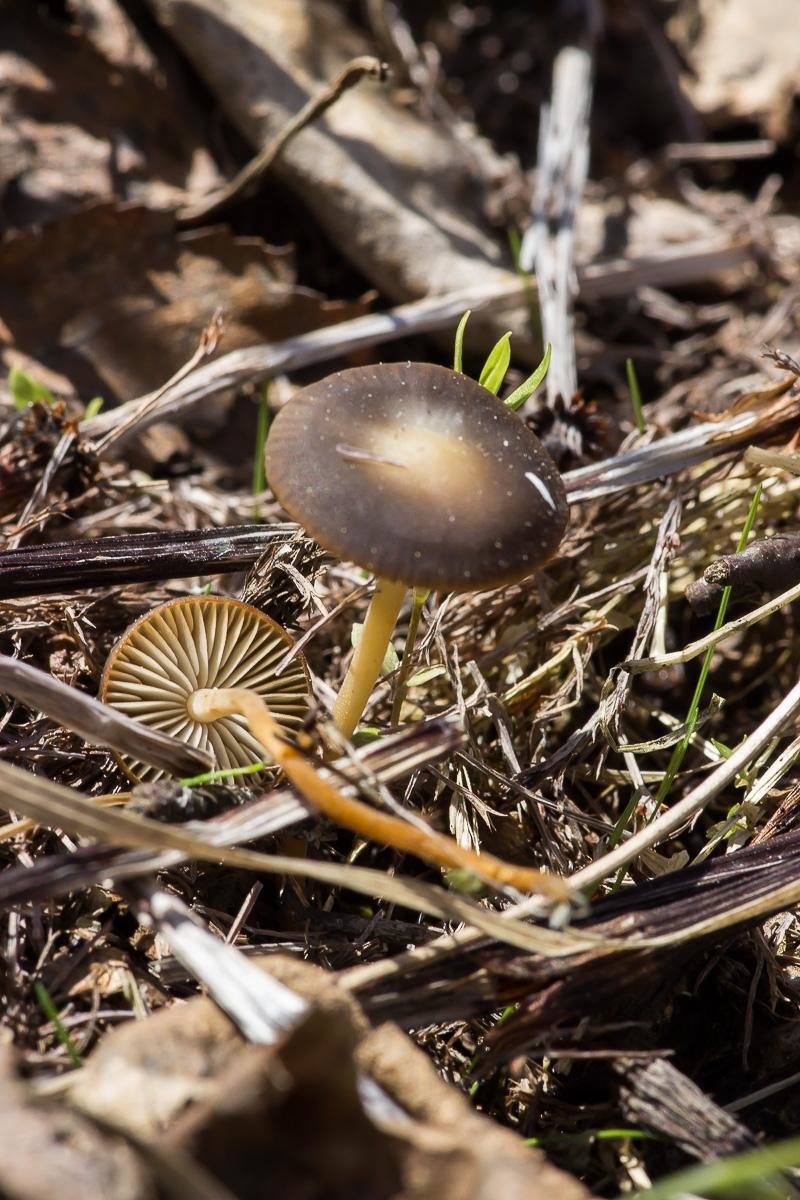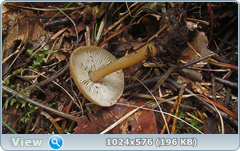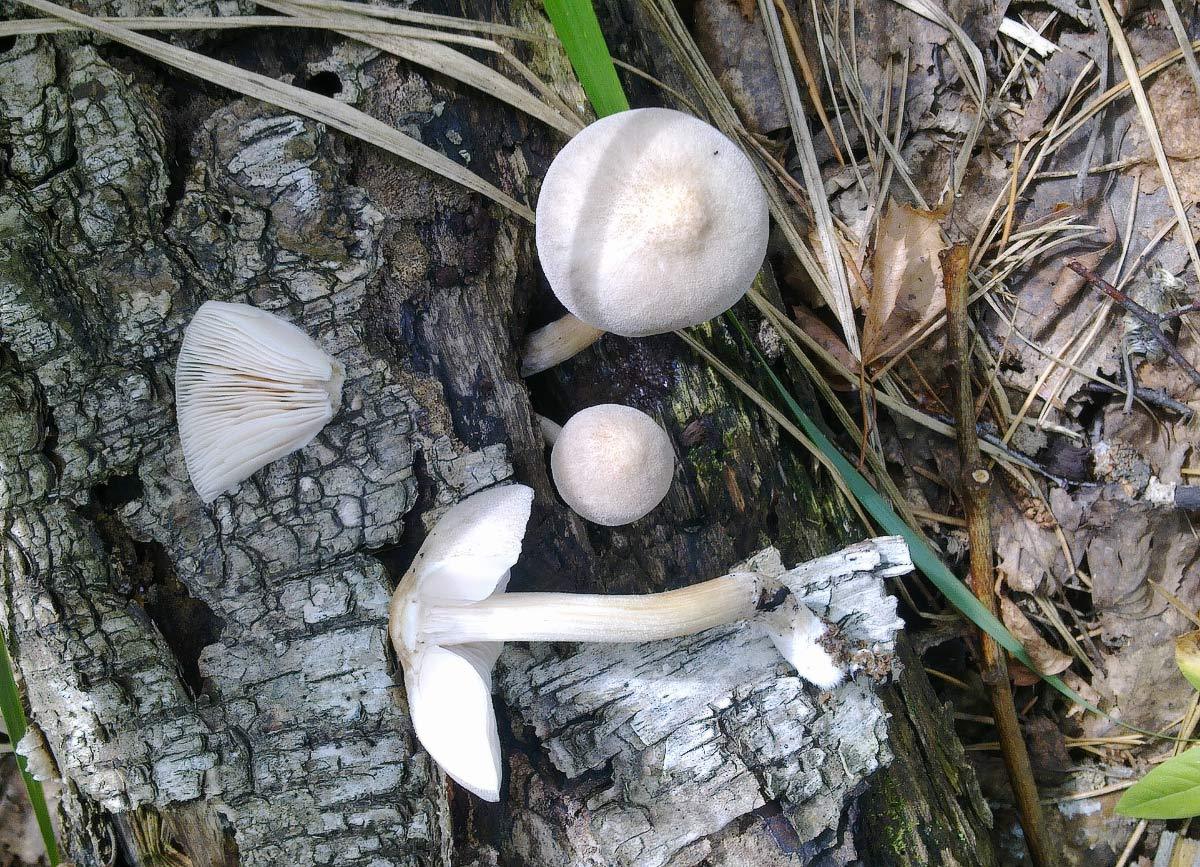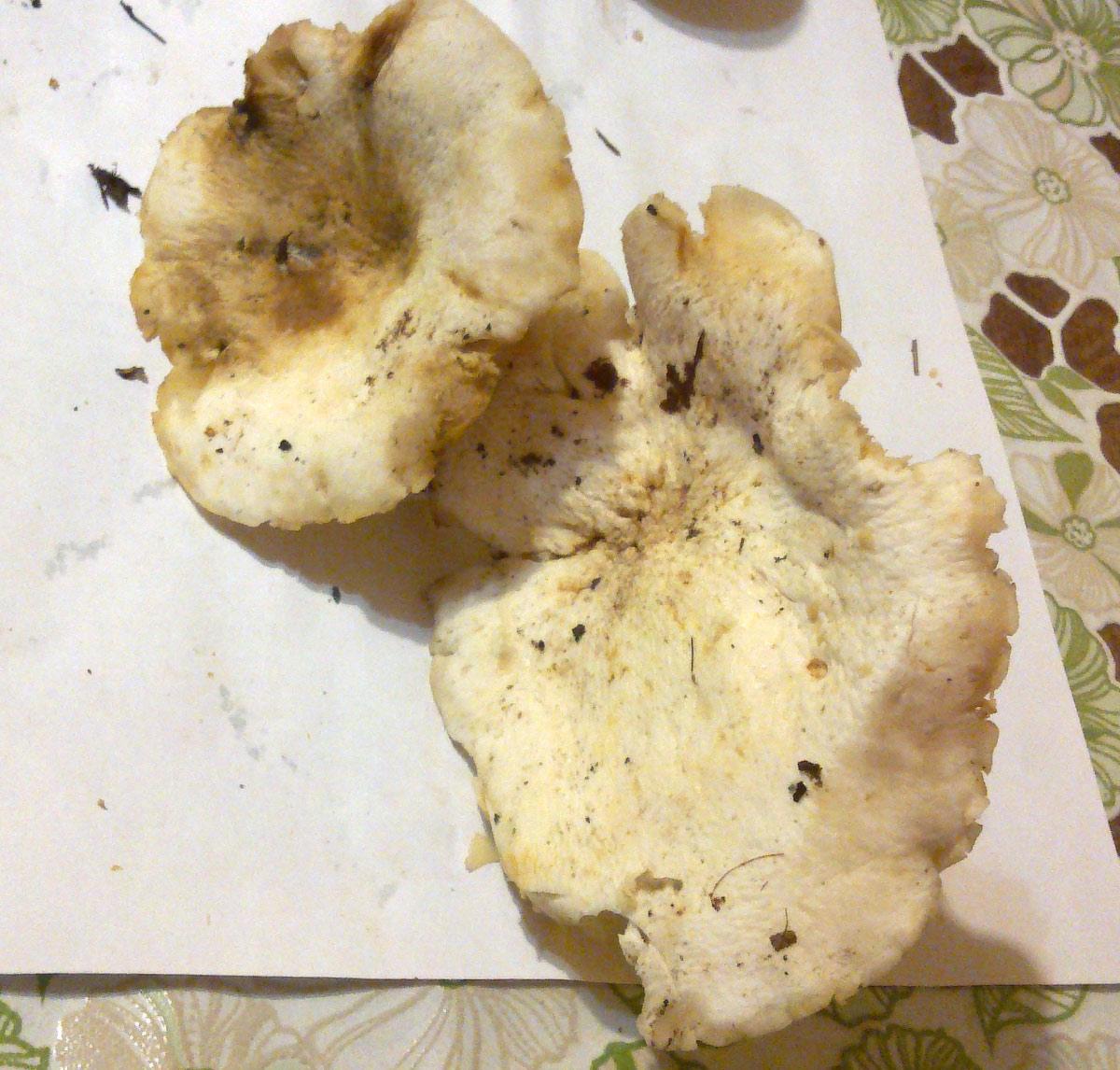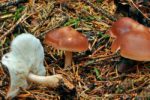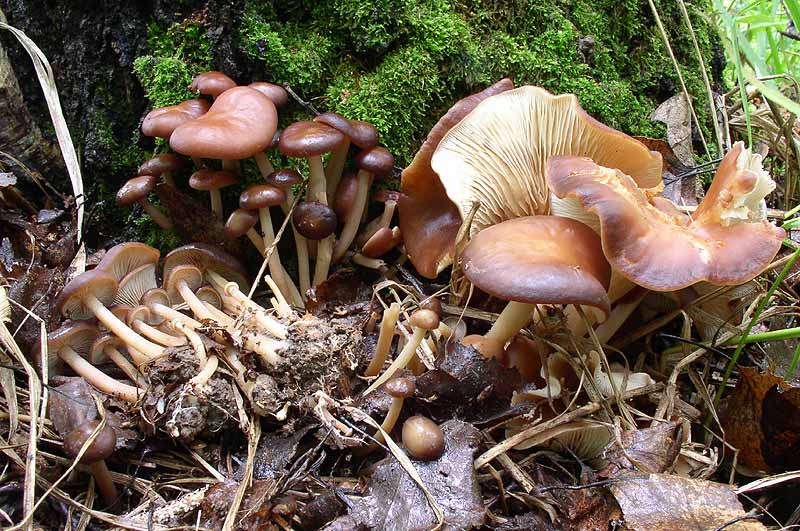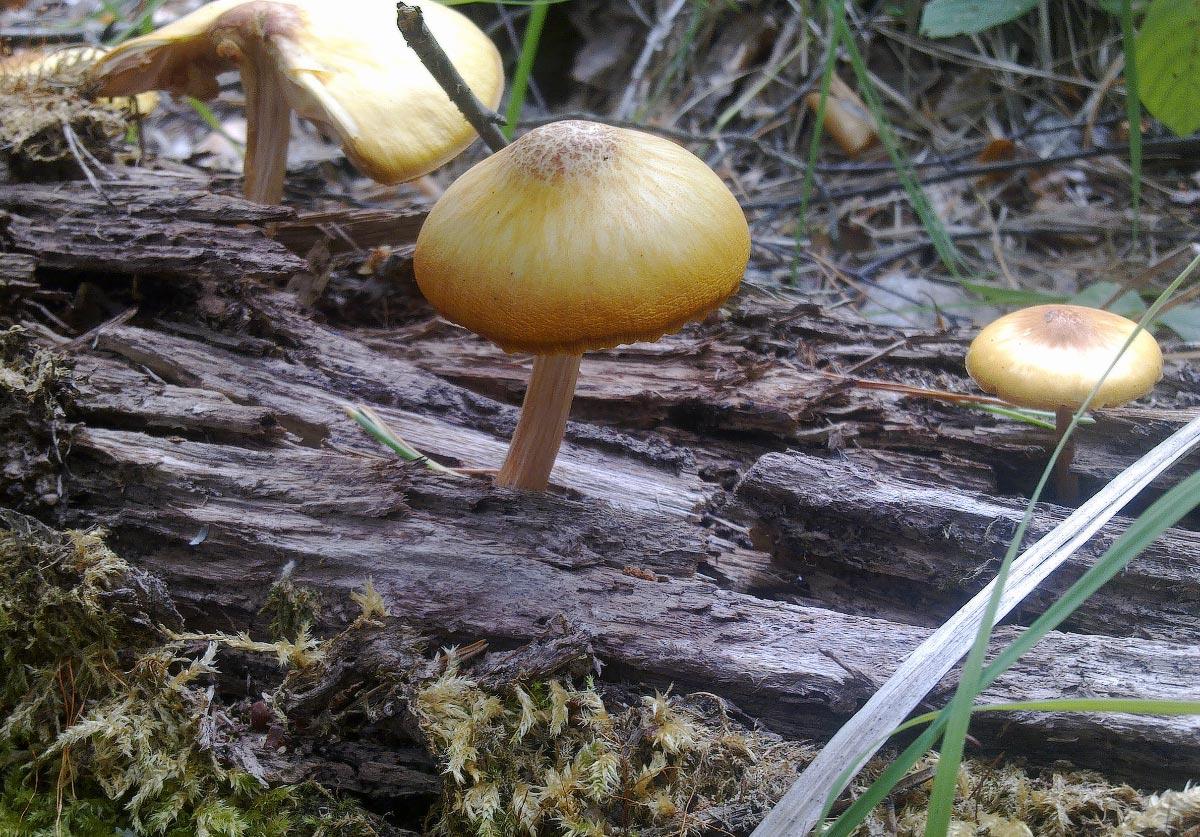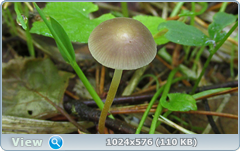Collibia yellow-lamellar (hymnopus yellow-lamellar, Gymnopusocior): what mushrooms look like, where and how they grow, are they edible or not
June mushrooms
Gymnopus ocior - Colibia yellow-lamellar
Chondrostereum purpureum - Chondrostereum purpureum
Clitocybe gibba - Funnel talker
Polyporus melanopus - Polyporus the black-footed
Cordyceps entomorrhiza - Cordyceps gray-ash
Mycena haematopus - Mycena haematopus
Trichophaea cf. abundans
Marasmius ramealis - Sprigel sprig
Paxillus involutus - Slender pig
Polyporus melanopus - Polyporus the black-footed
Sphaerobolus stellatus - Star spherobolus
Photogallery Mushrooms of April and May
All rights reserved Material is the property of the authors and this site
Pluteus leoninus - Plutey lion-yellow
Cyathus striatus - Striped goblet
Psathyrella candolleana - Psathyrella Candolle
Myxomycetes Um2 - Myxomycetes
Mycena pura - Mycena clean
Tubifera ferruginosa - Rusty tubifera
Trichophaea cf. abundans
Puccinia coronata - Puccinia crown
Bolbitius reticulatus - Bolbitius reticulated
Hypocrea sulphurea - Sulfur-yellow hypocrea
Anthracobia cf. maurilabra - Dark-bordered Anthracobia
The photographs presented in this gallery were taken with a digital camera Canon PowerShot A630
Collybia dryophila - Collybia the lesbian
Cordyceps entomorrhiza - Cordyceps gray-ash
Lactarius tabidus - Stunted Miller
Polyporus badius - Chestnut Polyporus
Cordyceps entomorrhiza - Cordyceps gray-ash
Scutellinia sp. - Scutellinia
Artomyces pyxidatus - Artomyces piriformis
Leccinum scabrum - Common boletus
Hapalopilus rutilans - Hapalopilus reddish
Ceratiomyxa porioides - Ceratiomixa poria
Continuation of the photo gallery Mushrooms of June
general characteristics
All members of the Collibia genus have similar characteristics:
- Hat: thin-fleshy, in rare cases has a well-developed flesh, small in size, does not exceed 2 cm in diameter, convex in shape at the initial stage of growth, subsequently flat-spread, in adult specimens a fossa appears in the central part, in young mushrooms it has rolled edges, pale in shades of white, brown and yellow.
- Hymenophore: formed by frequent plates adhered to the bases of the mushroom stem or free, the color of the hymenophore plates can be pale cream or light brown.
- Leg: thin, covered with a mealy bloom, the lower part of the leg is usually hairy, the shape of the leg is often even, cylindrical, in some cases swollen.
Some types of colibia form sclerotia.
Similar types and differences from them
Edible
- The hymnopus is water-loving, or Colibia is water-loving. This species differs from the early ripening Gymnopus in a lighter color of the cap and leg. It does not have a thin, pale streak around the edges. The leg, widening downward, turns into a pronounced bulb covered with ocher and pinkish mushroom filaments, and not white, as in the yellow-lamellar twin.
- The hymnopus is oak-loving, or Colibia is oak-loving. It differs from the early maturing Colibia in the paler color of the caps and legs.
- Alpine hymnopus, or Collibia alpine. Unlike Gymnopus yellow-lamellar, it has larger spores. These species are so similar that the differences between them can only be seen under a microscope.
Conditionally edible
Les-loving hymnopus, or Les-loving Collibia. It differs from the double in the white plate bottom of the hats. Its caps are painted in lighter shades and do not have a thin pale strip along the edges.
Definitioner
Lat. Basidia. A specialized structure of sexual reproduction in fungi, inherent only in Basidiomycetes. Basidia are terminal (end) elements of hyphae of various shapes and sizes, on which spores develop exogenously (outside).
Basidia are diverse in structure and method of attachment to hyphae.
According to the position relative to the axis of the hypha, to which they are attached, three types of basidia are distinguished:
Apical basidia are formed from the terminal cell of the hypha and are located parallel to its axis.
Pleurobasidia are formed from lateral processes and are located perpendicular to the axis of the hypha, which continues to grow and can form new processes with basidia.
Subasidia are formed from a lateral process, turned perpendicular to the axis of the hypha, which, after the formation of one basidium, stops its growth.
Based on morphology:
Holobasidia - unicellular basidia, not divided by septa (see Fig. A, D.).
Phragmobasidia are divided by transverse or vertical septa, usually into four cells (see Fig. B, C).
By type of development:
Heterobasidia consists of two parts - hypobasidia and epibasidia developing from it, with or without partitions (see Fig. C, B) (see Fig. D).
Homobasidia is not divided into hypo- and epibasidia and in all cases is considered holobasidia (Fig. A).
Basidia is the place of karyogamy, meiosis and the formation of basidiospores. Homobasidia, as a rule, is not functionally divided, and meiosis follows karyogamy in it. However, basidia can be divided into probasidia - the site of karyogamy and metabasidia - the site of meiosis. Probasidium is often a dormant spore, for example in rust fungi. In such cases, probazidia grows with metabasidia, in which meiosis occurs and on which basidiospores are formed (see Fig. E).
See Karyogamy, Meiosis, Gifa.
Lat. Pileipellis, skin - differentiated surface layer of the cap of agaricoid basidiomycetes. The structure of the skin in most cases differs from the inner flesh of the cap and may have a different structure. The structural features of pileipellis are often used as diagnostic features in descriptions of fungi species.
According to their structure, they are divided into four main types: cutis, trichoderma, hymeniderma and epithelium.
See Agaricoid fungi, Basidiomycete, Cutis, Trichoderma, Gimeniderm, Epithelium.
Collibia crowded (Gymnopus acervatus) what mushrooms look like, where and how they grow, are they edible or not
Collibia crowded: photo and description
| Name: | Collibia crowded |
| Latin name: | Gymnopus acervatus |
| View: | Conditionally edible |
Collibia crowded - conditionally edible forest dweller. It grows on stumps and decayed coniferous wood. Caps of young mushrooms are used for food, since the flesh of old specimens is tough and fibrous
Because this species has inedible counterparts, it is important to get acquainted with the external description, analyze its photos and videos
How does Collibia look crowded?
Colibia crowded is prescribed for edibility group 4. In order not to be deceived during mushroom hunting and not to collect toxic specimens, you first need to get acquainted with the external parameters.
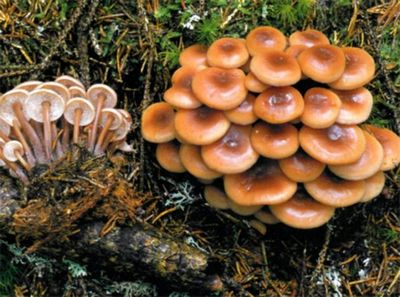
Description of the hat
The cap is small, up to 4 cm in diameter. In young mushrooms, the shape is convex, straightens with age, leaving a small mound in the very center. The surface on a matte base is smooth, covered with a dark brown paint. In dry weather, the skin becomes wrinkled, brightens and takes on a fawn color. The pulp is dense, watery, without a pronounced taste and smell.
The spore layer is formed by thin, innumerable plates, which are connected to the pedicle at a young age, and then become free. The plates are colored light lemon. This species reproduces by whitish, ovoid spores that are embedded in a white spore powder.
Eat a mushroom or not
This representative belongs to conditionally edible species. Only the upper part of young specimens is suitable for cooking. Before cooking, the harvested crop is sorted out, washed and boiled for 10-15 minutes. Then the mushrooms can be stewed, fried and preserved.
Where and how it grows
Large mushroom families prefer to grow on stumps and decaying coniferous wood. They can be seen along paths, in parks and squares, on the hillsides. Begins fruiting from July to October.
Doubles and their differences
This species, like all the inhabitants of the forest, has edible and inedible counterparts. These include:
- Red-footed is an edible species with a reddish-brown cap and a thin, long stem that is painted in the color of the cap. It prefers to grow on stumps among deciduous trees. It bears fruit during the entire warm period.
- Spindle-footed is an inedible species that loves to grow on stumps and rotting wood.You can recognize it by its smaller size and fusiform stem. Begins fruiting in the period from July to September.
- Oil - belongs to the 4th group of edibility, grows from July to October among spruce and deciduous trees. Small representatives have a dense, glossy surface. In the rain, it becomes shiny and covered with mucus. The pulp without a pronounced taste and smell. Only young specimens are used in cooking.
Conclusion
The crowded colliery is a conditionally edible specimen of the Negniychnikov family. It grows on stumps and felled wood, bears fruit throughout the warm period. In cooking, only the part on top is used, which is washed and boiled in advance. Since the mushroom is very similar to toadstools, only an experienced mushroom picker should carry out their collection.
Hymnopus early maturing (Gymnopus ocior)
Current title
| Index Fungorum | Gymnopus ocior (Pers.) Antonín & Noordel. | |
| MycoBank | Gymnopus ocior (Persoon) Antonín & Noordeloos |
Systematic position
Etymology of the species epithet
Ōcior, ōris сompar .; no posit. 1) faster, faster; rather acting; 2) earlier, early maturing.
Synonyms
- Agaricus ocior Pers., Mycol. eur. (Erlanga) 3: 151 (1828)
- Collybia ocior (Pers.) Vilgalys & O.K. Mill., Trans. Br. mycol. Soc. 88 (4): 467 (1987)
- Collybia xanthopus (Fr.) Sacc., Syll. fung. (Abellini) 5: 226 (1887)
- Collybia funicularis (Fr.) Métrod, Revue Mycol., Paris 17: 90 (1952)
- Collybia succinea Quél., Mém. Soc. Émul. Montbéliard, Sér. 2 5: 237 (1872)
- Collybia extuberans (Fr.) Quél., Mém. Soc. Émul. Montbéliard, Sér. 2 5: 237 (1872)
- Rhodocollybia extuberans (Fr.) Lennox, Mycotaxon 9 (1): 222 (1979)
- Collybia luteifolia Gillet, Hyménomycètes (Alençon): 328 (1876)
Other names: Collibia yellow-lamellar.
Habit
Fruit body: Cap and stem (agaricoid)
Hymenophore: Lamellar (including folded or with rudimentary plates)
Hat
The cap is 10 - 40 mm in diameter, initially convex, then prostrate with a tubercle in the center and an uneven edge, hygrophane, dark red or orange-brown, with a narrow yellow, yellow-red annular zone along the edge. The surface is smooth, slippery in wet weather.
The plates are adherent or adherent with a tooth, yellow, cream or white.
Smell and taste are weak, mushroom.
Leg
Stem 20 - 60 mm long, 2 - 5 mm in diameter, cylindrical, sometimes widening towards the base, hollow, smooth, yellow, ocher, reddish brown, darker downward.
Microscopy
Spore powder from white to cream color.
Spores (4.6) 5.1 - 6.3 × 2.5 - 3.5 (4.0) μm, Q = 2.0, broadly ellipsoid or ovoid.
Basidia 18 - 22 × 5.0 - 8.0 μm, clavate, 4-spore, with a buckle at the base.
Basidiols 11 - 21 × 3.0 - 9.0 μm, clavate, cylindrical or fusiform.
The edge of the plate is sterile.
Cheilocystids 12 - 45 × 3.0 - 9.0 µm, irregular, clavate, with outgrowths or with a spherical end, less often coral-shaped, thin-walled, sometimes inlaid.
Pleurocystids are absent.
Trama laminae consists of branched cylindrical hyphae up to 9.0 µm in diameter.
Pileipellis consists of hyphae 7.0 - 19 µm in diameter, with lobed terminal elements.
Buckles are common.
Ecology and distribution
- Substance: Woody plants (living trees, bark and dead wood)
- Substrate: Soil, litter
It grows, as a rule, in groups on the soil, among grasses, mosses or on decaying wood in deciduous, coniferous and mixed forests. In Novosibirsk Akademgorodok, it is common throughout the warm season in forest plantations and park areas, preferring shaded areas rich in organic matter, including those from dog walking, areas with sparse grassy cover.
Fruiting
The divisions correspond to the decades of the month.
Nutritional properties
Similar species
- Alpine hymnopus (Gymnopus alpinus) - differs mainly in the form of cheilocystids and in the large size of the spores.
- Gymnopus oak-loving (Gymnopus dryophilus) - lighter in color.
Related materials
- Antonin V., Noordeloos N. E. A monograph of marasmioid and collybioid fungi in Europe. - Eching: IHW-VERLAG, 2010 .-- 480 p. - P. 179.
- Knudsen H., Vesterholt J., eds. Funga Nordica. - Copenhagen: Nordsvamp, 2012 .-- P. 345.
Link to this page for prints
Ageev D.V., Bulonkova T.M. Early ripening hymnopus (Gymnopus ocior) - Mushrooms of Siberia URL: https://mycology.su/gymnopus-ocior.html (date of access: 28.02.
Share link
Discussions
| Identifier: | 11424 |
| Responsible: | Dmitry Ageev |
| Date of creation: | 2016-01-21T01: 31: 23 |
| Last modified date: | 2018-11-15T05: 41: 50 (Dmitry Ageev) |
OOO OOO OOO OOO OOO OOO OOO OOO OOO OOO OOO OOO OOO OOO OOO OOO OOO OOO OOO OOO OOO OOO OOO OOO OOO OOO OOO OOO OOO OOO OOO OOO OOO OOO OOO OOO OOO OOO OOO OOO OOO OOO OOO OOO OOO OOO OOO OOO OOO OOO OOO OOO OOO OOO OOO OOO OOO OOO OOO OOO OOO OOO OOO OOO OOO OOO OOO OOO OOO OOO OOO OOO OOO OOO OOO OOO OOO OOO OOO OOO OOO OOO OOO OOO OOO OOO OOO OOO OOO OOO OOO OOO OOO OOO OOO OOO OOO OOO OOO OOO OOO OOO OOO OOO OOO OOO OOO OOO OOO OOO OOO OOO OOO OOO OOO OOO OOO OOO OOOì
Age restrictions
Federal Law of the Russian Federation of December 29, 2010 No. 436-FZ "On the Protection of Children from Information Harmful to Their Health and Development."
Gymnopus yellow-lamellar
Description
A hat with a diameter of 2-4 (up to 6) cm, convex in youth, then prostrate with a lowered edge, then flat-prostrate, with a tubercle. The edges of the cap in youth are even, then often wavy. The color is dark red, red-brown, dark brown, the center is lighter, the edges are darker. Along the very edge there is a narrow, light, yellow stripe. The surface of the cap is smooth.
Bedspread: absent.
The pulp is whitish, yellowish, thin, elastic. The smell and taste are not pronounced.
The plates are frequent, free, at a young age they are weakly and deeply adhered. The color of the plates is yellowish, after the ripening of the spores, yellowish-cream. There are shortened plates that do not reach the stem in large numbers. Some sources also admit the white color of the plates.
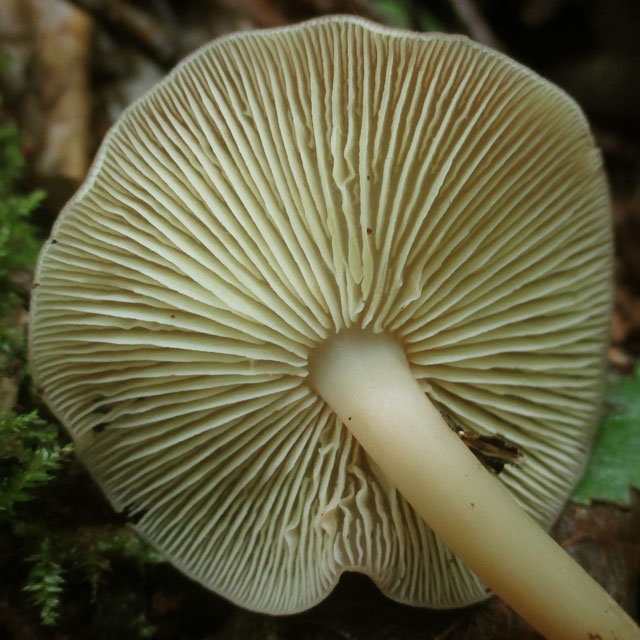
White to off-white spore powder. The spores are elongated, smooth, ellipsoid or ovoid, 5-6.5 x 2.5-3-5 μm, not amyloid.
Leg 3-5 (up to  cm, 2-4 mm in diameter, cylindrical, pinkish-brownish, light ocher, yellowish-brownish, often curved, curved. It can expand at the bottom. White rhizomorphs fit to the bottom of the leg.
cm, 2-4 mm in diameter, cylindrical, pinkish-brownish, light ocher, yellowish-brownish, often curved, curved. It can expand at the bottom. White rhizomorphs fit to the bottom of the leg.
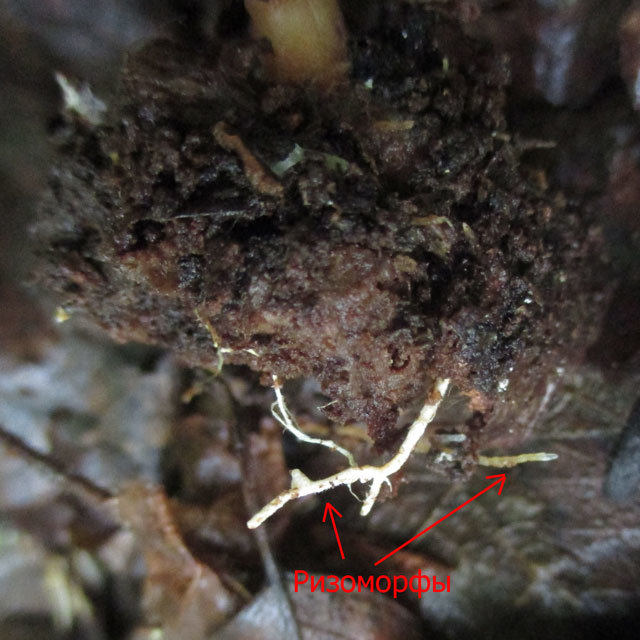
Similar species
- Colibia (Gymnopus) wood-loving (Gymnopus dryophilus) - has plates without a yellow tint, has a much lighter shade of the cap, does not have a narrow light strip along the edge.
- Colibia (Gymnopus) water-loving (Gymnopus aquosus) - This mushroom is lighter, does not have a narrow light strip along the edge, has a much stronger, sharper, bulbous thickening at the bottom of the stem (uniquely identifying this species) and pinkish or ocher rhizomorphs (not white) ...
- Collibia (Gymnopus) alpine (Gymnopus alpinus) - differs only in microscopic features, large spore size and the shape of cheilocystids.
Edibility
An edible mushroom, completely analogous to the wood-loving colibia.
Mushroom photo Gymnopus yellow-lamellar from questions in recognition:
Collibia tailed (Xerula radicata)
- Other names for the mushroom:
- Xerula root
- Udemanciella root
- Root money
Synonyms:

The current name is Hymenopellis radicata (according to Species Fungorum).
The tailed colliery attracts attention immediately, it is able to surprise with its appearance and is a very special species. Hat: 2-8 cm in diameter
But, due to the very high leg, it seems that the cap is much smaller. At a young age, it has the shape of a hemisphere, in the process of maturation it gradually opens up and becomes practically prostrate, while maintaining a noticeable tubercle in the center. The surface of the cap is moderately mucous with pronounced radial wrinkles. Changeable color, from olive, greyish brown to dirty yellow
Hat: 2-8 cm in diameter. But, due to the very high leg, it seems that the hat is much smaller. At a young age, it has the shape of a hemisphere, in the process of maturation it gradually opens up and becomes practically prostrate, while maintaining a noticeable tubercle in the center. The surface of the cap is moderately mucous with pronounced radial wrinkles. The color is changeable, from olive, greyish-brown to dirty yellow.
Pulp: light, thin, watery, without any special taste or smell.
Plates: moderately sparse, adhered in places in youth, then become free. The color of the plates as the mushroom matures ranges from white to grayish-cream.
Spore powder: white
Leg: up to 20 cm in length, 0.5-1 cm thick. The leg is deep, almost 15 cm immersed in the soil, often twisted, has a specific rhizome. The color of the stem ranges from brown at the bottom to almost white at the base. The pulp of the leg is fibrous.
Distribution: Collibia caudate occurs from mid to late July. Sometimes it comes across until the end of September in various forests. Prefers tree roots and heavily decayed wood remains. Due to the long stem, the mushroom forms deep underground and only partially crawls out to the surface.
Similarity: The appearance of the fungus is rather unusual, and the characteristic rhizome process does not allow Oudemansiella radicata to be mistaken for any other species. Udemansiella root is easy to identify due to its lean structure, tall growth and powerful root system. It looks like a long-legged Xerula, but the latter has a velvety hat, has pubescence.
Edible: In principle, the Collibia tailed mushroom is considered edible. Some sources claim that the mushroom contains some medicinal substances. This mushroom can be safely eaten.
Notes: Collibia tailed beasts are located at some distance from other types of fungi. It is easy to recognize at first glance: a very long leg and a short hat give the impression that nails are coming out of the ground, hammered by someone unknown, it is difficult to call it even a mushroom.
Description
Hat
In a young fungus, it is convex, then acquires a prostrate shape with a lowered edge; in older specimens, the cap is almost flat, with a central tubercle and a wavy edge. The size of the cap reaches 6, sometimes 10 cm in diameter. The skin of the cap is smooth, matte; in wet weather, it is covered with an abundant layer of mucus. The flesh of the cap is able to actively absorb water, due to which it swells and darkens strongly during rains. The color of the cap varies from red to dark brown, depending on the moisture content. The center of the cap is paler, along its edge there is also a light-colored "belt".
Spore-bearing layer
Lamellar. Coloring from white to yellowish, in older specimens with a creamy shade of color. The plates adhered to the stem in the youth of the fungus and are freely located later. Plates are frequent, many are shortened, not reaching the stem. Spore powder from yellowish to cream color, ellipsoidal spores.
Leg
Cylindrical, regular or curved, up to 6, occasionally 8 cm in height and about 4 millimeters in diameter. It is colored brown of varying intensity with a pink, ocher or yellowish tint, widening downward. White filaments of mycelium are clearly visible at the base. The structure of the leg is dense, rather fragile, and solid.
Pulp
White or yellowish, when damaged, does not change its color, does not emit milky juice. It has no pronounced smell and taste.
Edible mushrooms, berries, herbs
Collybia fusipes
Spindle-footed collibia can be found from the second decade of July to the third decade of September in deciduous forests (most often, where there is an oak or a beech). It prefers to grow near oak (beech) stumps, tree roots, along fallen trunks, around stumps. It grows in rather large groups, united in bundles-aggregates. It is most widespread in the southern regions of our country.
The cap is 3-8 cm in diameter. At first, it is bell-shaped, later it is convex-tuberous with a smooth surface. The color is brownish-brownish or reddish-reddish-brownish with a darker center. In adults, the surface of the cap is most often uneven with cracked edges, while the color becomes lighter. Also, specks of red-brown color may appear on the surface.
The plates are sparse, medium-frequency, weakly accrete, grayish-white with reddish-brown spots.
The leg has a fusiform shape, swollen just below the middle. 6-9 cm long, 0.5-1.8 cm in diameter. The structure is longitudinally fibrous, wrinkled-furrowed. In the swollen part it is almost hollow, light at the top, red-brown at the bottom, brown at the very base. Very often, the leg is twisted or twisted longitudinally.
The pulp is white, thin-fleshy, elastic, harsh in the leg, with a subtle smell.
It is considered a weakly poisonous mushroom. However, in some reference books it is equated to edible or conditionally edible. For example, the French mycologist-writer Gerard Oudou in his encyclopedia "Mushrooms" advises to collect the caps of young spindle-footed colibia and use them fresh or pickled.
Photos of Collybia fusipes



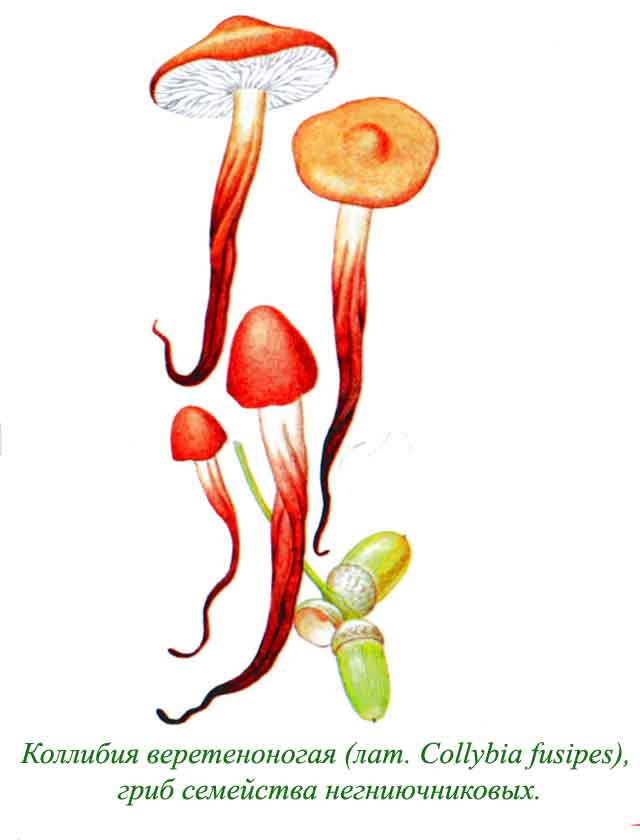
A video about spindle-footed collibia, which allows you to better understand the structure of the fruiting body and imagine how a mushroom grows in the forest.
The money is merging

In some forests, there are whole clusters of long-legged bell-shaped mushrooms, gathering in rosettes of 2-9 or more specimens. With this quality, they resemble honey mushrooms, stuck around the stumps with numerous families. However, confluent money, unlike edible mushrooms, is not recommended for culinary purposes.
The money is merging
Money confluent - Latin Gymnopus confluens
In another way, this pretty-looking fungus is called Colibia fused, Colibia fused, Colibia fused, Money fused, Colibia fused or Money fused.
Description
Mushroom cap
The caps of the young Colibia merging reach 20 mm in diameter, and have a convex hemisphere shape. As they grow, the diameter of the hats varies from 40 to 60 mm, and they themselves turn into wide cones or bells, similar to Vietnamese hats with mild mounds in the middle. Occasionally, depressions appear on the caps, often thin wavy edges.
The hat surface is covered with a smooth glossy skin, through which a lamellar bottom is visible at the edges. It is colored light ocher, brown ocher or dark red and has light edges. Over time, the caps fade to a fawn or cream shade.
From the inside, they are filled with watery, but tight flesh of a fawn tone. Under the hat there are many narrow accrete plates with small teeth along the edges. With age, the plates of Colibia growing together are separated from the leg. They are whitish or yellowish in color.
Fused money reproduces by whitish elongated spores contained in white spore powder.
Stipe
The length of the legs of the confluent money reaches 40-100 mm, the thickness is 2-5 mm. Longitudinally folded legs are cylindrical and do not fill with pulp.
The legs themselves are pretty stiff. At first, they turn whitish or yellow - ocher color, darkening downward. Adult mushrooms have rusty-red or reddish-brown legs, covered with the smallest whitish bloom. Their bases are much more pubescent.
Growing places
Collibia growing together prefers floodplain deciduous forests with alder, birch and poplar, it is found on stony areas, fallen leaves and litters.
Fruiting is often in a group: mushrooms, growing together by roots, form numerous rosettes. They bear fruit from July or August to November.
Although the flesh of these collibii has a mild taste, it smells so disgusting of rotten cabbage that it is not eaten, especially since the legs are very stiff.
Kollibia les-loving - description, where it grows, the poisonousness of the mushroom
According to the variety of mushrooms, the wood-loving colibia is classified as a non-nylon mushroom family. The people call this type of mushroom the spring mushroom for its external resemblance to honey agarics. However, such confusion often occurs due to the mistake and inexperience of the mushroom pickers themselves. In fact, colibia is considered a parasitic fungus and has nothing to do with mushrooms.
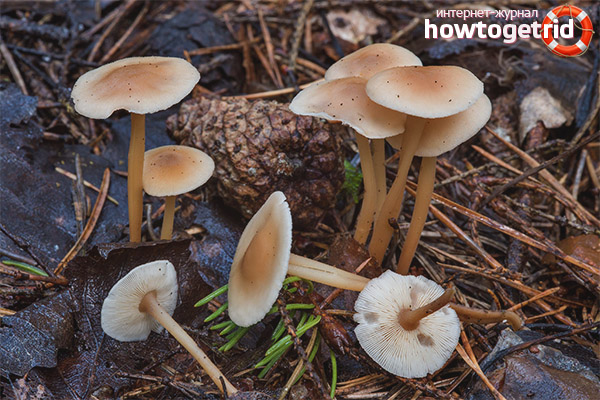
According to the edibility classification, the representative of the mushroom kingdom, the colibia, is usually classified as conditionally edible mushrooms of the fourth category. After the collibia is in the mushroom picker basket, it should be cooked. The mushroom must first be boiled and the resulting broth drained, only after that it can be used for food.
Characteristics of the forest-loving colibia
Young colibia mushrooms have a cap that looks like a sphere. As the mushroom develops, its cap takes on a spread, flat shape with transparent margins. The diameter of the mushroom cap reaches about 2-6 cm. Young colibia fungi have some similarity with apples that fell on fallen leaves in the forest.
The core of the mushroom has brown, light yellow or sometimes white flesh.The color of the pulp directly depends on the conditions and environment in which the mushroom matures. If you look through the thin and transparent edges of the cap, you can see the plates that are weakly attached to the base of the mushroom. The older the mushroom ripens, the more it will become covered with reddish spots that appear on the inside of the fruit. The transparent and thin edges start to tear.
The mushroom leg has a thin base, it is hollow inside and twists slightly along its length, at the end it thickens a little. The structure of the stem of the fungus has a fibrous and cartilaginous surface. The cap and leg are the same color. The mushroom leg can be up to 2 or 6 cm in length.
Is the les-loving kollibia edible?
Colibia is an edible mushroom, so it can be used in recipes. However, due to its low taste, it is not in great demand among mushroom pickers. In addition, if a person has disorders associated with digestive problems, then you should not use this mushroom for food. Colibia can cause intestinal and stomach ailments and painful sensations.
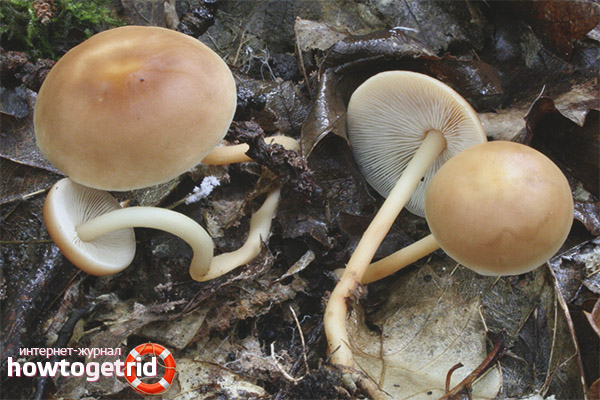
Colibia is also not very popular among chefs, as the inside of the mushroom has very little soft core and pulp for cooking. In addition, the mushroom does not have a strong aroma and taste. The aroma of colibia can even, on the contrary, give dishes an unpleasant smell with an admixture of mold and rot.
Growing environment of colibia
The habitat of the fungus is considered to be the forest, which is why the colibia is called wood-loving. You will not find her in fields or gardens. Colibia can be found in the deciduous and coniferous thickets of the forest. This type of mushroom family grows most often in the European part of Russia.
The first mushrooms germinate in May and give inputs until the end of autumn. Colibia can be found among foliage, in a damp lowland, in a rotting fallen tree or on a stump, thanks to which the fungus survives and receives the substances and water it needs. Also, the fungus can grow on the surface of the tree trunk.
Doubles in the kingdom of mushrooms
There are wood-loving kollibia and close relatives. Colibia is considered such a relative of the fungus; it also belongs to the conditionally edible varieties of mushrooms. The mushroom is brown or red-brown in color. Also, wood-loving kollibia can often be confused with some other species of the kolibia family, which, moreover, can be very poisonous and life-threatening. However, poisonous varieties are rare. Only experienced mushroom pickers can find the difference between a poisonous and an edible mushroom.

